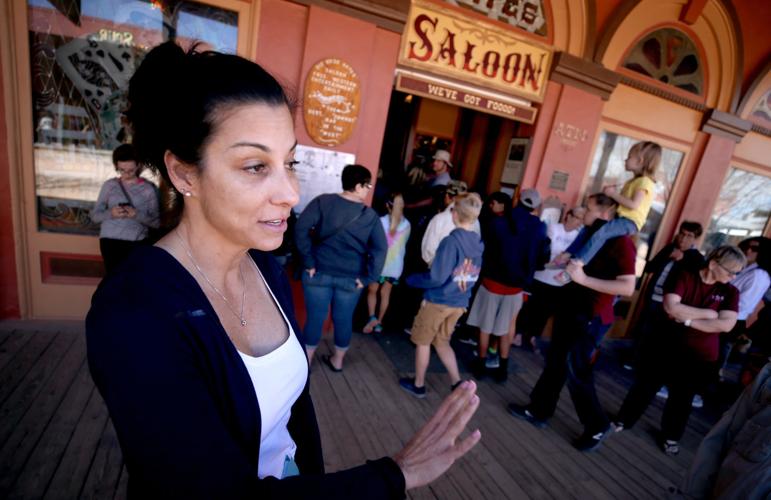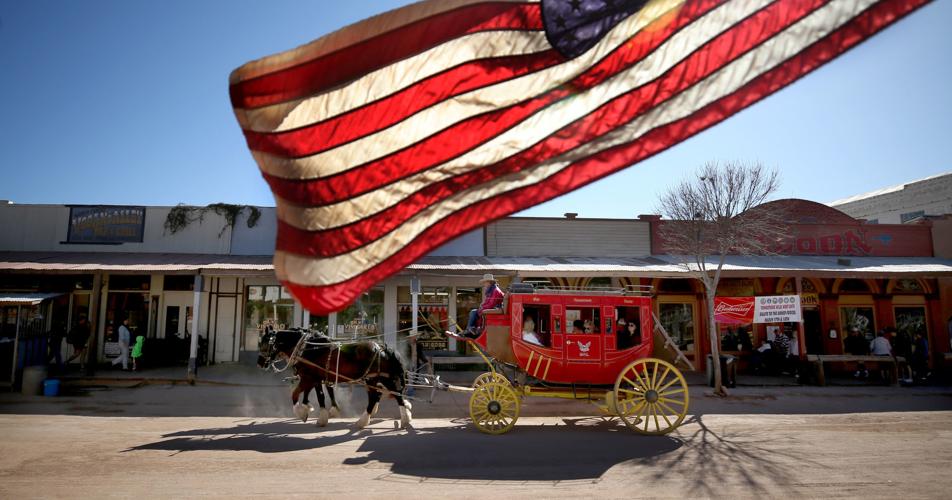Anthony Estrada said goodbye to his friend Larry Stricklin and was about to leave a Tombstone bar on Jan. 29 when Stricklin pulled out a gun and fired downward toward him, Estrada said. In this town where gunfights are re-enacted daily, and Estrada joins in the acting, he wasn’t sure what happened, he said.
“I didn’t even know I was hit till the karaoke guy came out and said I was spurting blood,” Estrada told me Thursday.
It was the second shooting at Doc Holliday’s Saloon, an Allen Street tavern in Tombstone, since October.
And it led to some tightening of regulations on guns in this town known for the looseness of its gun culture. Now, Doc Holliday’s no longer lets people check their guns behind the bar. Other taverns, like the Crystal Palace, now have signs saying “No Weapons Allowed.”
Even though last year the mayor proclaimed Tombstone “America’s Second Amendment City,” the pendulum is swinging back slightly in the direction of gun regulation in Tombstone.
The new ad hoc effort to limit guns in bars comes after the City Council in 2016 passed an ordinance regulating how actors are inspected before they re-enact gunfights on the streets of town.
As in America as a whole, the ownership of guns is common in Tombstone. But also as in the country as a whole, the town has struggled historically to balance the right to bear arms with laws and regulations that keep people safe. They and we are still finding the right balance.
The Oct. 26, 1881, shootout that made Tombstone infamous and keeps tourists flowing to this day began as an effort to enforce the town’s tough new gun ordinance. As of April 19 that year, the town’s new law said:
- It is hereby declared to be unlawful for any person to carry deadly weapons, concealed or otherwise (except the same be carried openly in sight, and in the hand) within the limits of the City of Tombstone.
- This prohibition does not extend to persons immediately leaving or entering the city, who, with good faith, and within reasonable time are proceeding to deposit, or take from the place of deposit such deadly weapon.
- All fire-arms of every description, and bowie knives and dirks, are included within the prohibition of this ordinance. (Dirks are short daggers.)
While there were pre-existing tensions, it was the Earps trying to disarm the Clantons in town that precipitated the shootout. And that ordinance didn’t then disappear as some sort of relic of a lawless time.
“Tombstone is a Second Amendment city,” Mayor Dusty Escapule told me Thursday.
“We believe in the right to bear arms and we believe everyone should have the right to bear arms for self-protection. But even in the 1880s, they didn’t allow you to carry a six-shooter in the bars. They wouldn’t let you have a six-shooter on the street. That stayed on the books until the 1970s.”
This wasn’t just a case of inertia. In 1977, the Tombstone City Council passed a new ordinance prohibiting carrying guns or knives longer than 3 inches, unless the individual has written permission — a provision intended for the city’s actors.
“As far as I’m concerned, we’ve got a good law, and we’re going to keep it,” then-Mayor Alex Gradillas said in 1992. “If we can’t keep things the way they are now, we may have to give up the (staged) shootouts that bring the people here.”
A lawsuit against the ordinance by three local residents, backed by the National Rifle Association, forced the city to rescind the law in 1994. In the ensuing years, there were an increasing number of incidents involving tourists who thought it was funny to pull a gun out and say “stick ‘em up.”
“It’s escapism. You go to Tombstone, and you’re in another place and time,” local historian Nancy Sosa told me. “Sometimes you get people who really think they’re Doc Holliday or Johnny Ringo.”
Still today, there is a confusing mash-up of historic and modern, pretend and real when it comes to Tombstone’s gun culture. Some people carry real guns, old-fashioned or new; others carry replicas; others carry prop guns — real guns with the barrel or cylinders plugged.
Those came together in October 18, 2015, when Tom Carter showed up running late for work as a Tombstone Vigilante, re-enacting the 1881 shootout.
His gun was not checked, as protocol called for, and he ended up shooting Ken Curtis in the groin with a live round that he had forgotten was loaded in his revolver.
In response, the City Council passed an ordinance in 2016 imposing regulations on re-enactors. The law requires background checks for all actors, a $1 million insurance policy that also indemnifies the city of Tombstone, a rope cordon and a strict checking of firearms that will be used in the performance.
The ordinance makes sense — it may also be illegal. A 2000 state law prohibits cities from making just about any local ordinance dealing with firearms. The Tombstone ordinance is a local gun law waiting to be challenged, even if it does make sense.
Down through the years, it has also been common for Tombstone saloons to allow customers to check their guns with the bartender.
“I think there was some misunderstanding of the specific liquor laws involving taking guns into bars,” Tombstone Marshall Bob Randall said.
“Specifically, taking a gun into a bar is illegal. Some were interpreting that if they were taking the gun into the bar, then checked the gun, taking it when they leave, that they were within the parameters of the law.”
Under state law, people with a concealed-carry permit may take a gun into a bar unless a prohibition is clearly posted, but they may not drink alcohol. How that’s enforced is confusing.
“We used to check guns, then the laws changed,” said Susan Wallace, co-owner of Big Nose Kate’s Saloon, which for years has had a sign prohibiting firearms at the door. She added, “If someone has a concealed carry, we’re not going to frisk them.”
Both shootings at Doc Holliday’s involved people who had checked guns in with the bartender. In October, James Roberson turned in a gun when he arrived, then picked it up when he was leaving. A fight ensued before he left the bar, and he ended up shooting a man, deputies said.
In January, Stricklin retrieved a checked gun before leaving, reloaded it in the bathroom, then shot Estrada before running away, Randall said. Stricklin was later arrested on suspicion of reckless discharge of a firearm and aggravated assault. The Cochise County Attorney’s Office has asked for additional interviews and evidence from the Tombstone Marshal’s Office before making a charging decision.
The Arizona Department of Liquor Licenses and Control is investigating both cases, too. The owners of Doc Holliday’s did not return messages seeking comment.
Tim Loomis, a new business owner in town, took matters into his own hands after the second Doc Holliday’s shooting — when Estrada was shot in the leg. It got ridiculous after Doc Holliday’s stopped checking guns: Some customers tucked their weapons up in the eaves to hide them before entering the bar. Now Loomis is offering to store guns for people in his shooting gallery next door to the bar, for a small fee.
With or without one of his revolvers, Estrada, a Tombstone native, still likes to hang out at the bar where he was shot, which he calls “my little hole in the wall.” He still hasn’t been able to return to acting because of his injury, though.
“I’m the last man to be shot on Allen Street and live,” he said.
But he’s moderated his views on firearms slightly. He’s fine with people carrying, as he was carrying, his .22 Thursday, but he wants background checks. Plus, he added, “Alcohol and guns do not go together.”
That’s the one firm ground rule Tombstone seems able to agree on now, as it feels its way toward resolving the same dilemma we’re in as a country — being the Second Amendment City that applies the right regulations to keep locals and visitors safe.









